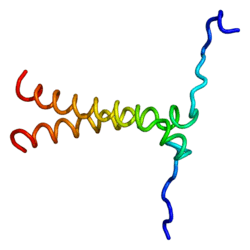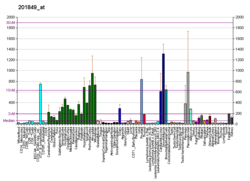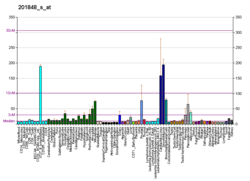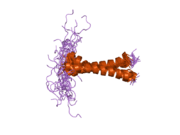BNIP3
BCL2/adenovirus E1B 19 kDa protein-interacting protein 3 is a protein that in humans is encoded by the BNIP3 gene.[5]
BNIP3 is a member of the apoptotic Bcl-2 protein family that is involved an atypical programmed cell death pathway resembling both necrosis and apoptosis. Many Bcl-2 family proteins modulate the permeability state of the outer mitochondrial membrane by forming homo- and hetero-oligomers. However, sequence similarity with Bcl-2 family members was not detected. Humans and other animals (Drosophila, Caenorhabditis), as well as lower eukaryotes (Dictyostelium, Trypanosoma, Cryptosporidium, Paramecium) encode several BNIP3 paralogues including the human NIP3L, which induces apoptosis by interacting with viral and cellular anti-apoptosis proteins.
Structure
The right-handed parallel helix-helix structure of the domain with a hydrogen bond-rich His-Ser node in the middle of the membrane, accessibility of the node for water, and continuous hydrophilic track across the membrane suggest that the domain can provide an ion-conducting pathway through the membrane. Incorporation of the BNIP3 transmembrane domain into an artificial lipid bilayer resulted in a pH-dependent conductivity increase. Necrosis-like cell death induced by BNIP3 may be related to this activity.[6]
Function
BNIP3 interacts with the E1B 19 kDa protein which is responsible for the protection of virally induced cell death, as well as E1B 19 kDa-like sequences of BCL2, also an apoptotic protector. This gene contains a BH3 domain and a transmembrane domain, which have been associated with pro-apoptotic function. The dimeric mitochondrial protein encoded by this gene is known to induce apoptosis, even in the presence of BCL2.[7] Change of BNIP3 expression along other members of the Bcl-2 family measured by qPCR captures important characteristics of malignant transformation, and are defined as markers of resistance toward cell death, a key Cancer Hallmark.[8]
Transport reaction
The reaction catalyzed by BNIP3 is:
- small molecules (out) ⇌ small molecules (in)
Interactions
BNIP3 has been shown to interact with CD47,[9] BCL2-like 1[10] and Bcl-2.[5][10]
References
- 1 2 3 GRCh38: Ensembl release 89: ENSG00000176171 - Ensembl, May 2017
- 1 2 3 GRCm38: Ensembl release 89: ENSMUSG00000078566 - Ensembl, May 2017
- ↑ "Human PubMed Reference:".
- ↑ "Mouse PubMed Reference:".
- 1 2 Boyd JM, Malstrom S, Subramanian T, Venkatesh LK, Schaeper U, Elangovan B, D'Sa-Eipper C, Chinnadurai G (Oct 1994). "Adenovirus E1B 19 kDa and Bcl-2 proteins interact with a common set of cellular proteins". Cell. 79 (2): 341–51. doi:10.1016/0092-8674(94)90202-X. PMID 7954800.
- ↑ Bocharov EV, Pustovalova YE, Pavlov KV, Volynsky PE, Goncharuk MV, Ermolyuk YS, Karpunin DV, Schulga AA, Kirpichnikov MP, Efremov RG, Maslennikov IV, Arseniev AS (June 2007). "Unique dimeric structure of BNip3 transmembrane domain suggests membrane permeabilization as a cell death trigger". The Journal of Biological Chemistry. 282 (22): 16256–66. doi:10.1074/jbc.M701745200. PMID 17412696.
- ↑ "Entrez Gene: BNIP3 BCL2/adenovirus E1B 19kDa interacting protein 3".
- ↑ Menyhárt O, Harami-Papp H, Sukumar S, Schäfer R, Magnani L, de Barrios O, Győrffy B (December 2016). "Guidelines for the selection of functional assays to evaluate the hallmarks of cancer". Biochimica et Biophysica Acta. 1866 (2): 300–319. doi:10.1016/j.bbcan.2016.10.002. PMID 27742530.
- ↑ Lamy L, Ticchioni M, Rouquette-Jazdanian AK, Samson M, Deckert M, Greenberg AH, Bernard A (Jun 2003). "CD47 and the 19 kDa interacting protein-3 (BNIP3) in T cell apoptosis". The Journal of Biological Chemistry. 278 (26): 23915–21. doi:10.1074/jbc.M301869200. PMID 12690108.
- 1 2 Ray R, Chen G, Vande Velde C, Cizeau J, Park JH, Reed JC, Gietz RD, Greenberg AH (Jan 2000). "BNIP3 heterodimerizes with Bcl-2/Bcl-X(L) and induces cell death independent of a Bcl-2 homology 3 (BH3) domain at both mitochondrial and nonmitochondrial sites". The Journal of Biological Chemistry. 275 (2): 1439–48. doi:10.1074/jbc.275.2.1439. PMID 10625696.
Further reading
- Kataoka N, Ohno M, Moda I, Shimura Y (Sep 1995). "Identification of the factors that interact with NCBP, an 80 kDa nuclear cap binding protein". Nucleic Acids Research. 23 (18): 3638–41. doi:10.1093/nar/23.18.3638. PMC 307259. PMID 7478990.
- Maruyama K, Sugano S (Jan 1994). "Oligo-capping: a simple method to replace the cap structure of eukaryotic mRNAs with oligoribonucleotides". Gene. 138 (1–2): 171–4. doi:10.1016/0378-1119(94)90802-8. PMID 8125298.
- Suzuki Y, Yoshitomo-Nakagawa K, Maruyama K, Suyama A, Sugano S (Oct 1997). "Construction and characterization of a full length-enriched and a 5'-end-enriched cDNA library". Gene. 200 (1–2): 149–56. doi:10.1016/S0378-1119(97)00411-3. PMID 9373149.
- Chen G, Ray R, Dubik D, Shi L, Cizeau J, Bleackley RC, Saxena S, Gietz RD, Greenberg AH (Dec 1997). "The E1B 19K/Bcl-2-binding protein Nip3 is a dimeric mitochondrial protein that activates apoptosis". The Journal of Experimental Medicine. 186 (12): 1975–83. doi:10.1084/jem.186.12.1975. PMC 2199165. PMID 9396766.
- Yasuda M, Theodorakis P, Subramanian T, Chinnadurai G (May 1998). "Adenovirus E1B-19K/BCL-2 interacting protein BNIP3 contains a BH3 domain and a mitochondrial targeting sequence". The Journal of Biological Chemistry. 273 (20): 12415–21. doi:10.1074/jbc.273.20.12415. PMID 9575197.
- Chen G, Cizeau J, Vande Velde C, Park JH, Bozek G, Bolton J, Shi L, Dubik D, Greenberg A (Jan 1999). "Nix and Nip3 form a subfamily of pro-apoptotic mitochondrial proteins". The Journal of Biological Chemistry. 274 (1): 7–10. doi:10.1074/jbc.274.1.7. PMID 9867803.
- Yasuda M, Han JW, Dionne CA, Boyd JM, Chinnadurai G (Feb 1999). "BNIP3alpha: a human homolog of mitochondrial proapoptotic protein BNIP3". Cancer Research. 59 (3): 533–7. PMID 9973195.
- Ohi N, Tokunaga A, Tsunoda H, Nakano K, Haraguchi K, Oda K, Motoyama N, Nakajima T (Apr 1999). "A novel adenovirus E1B19K-binding protein B5 inhibits apoptosis induced by Nip3 by forming a heterodimer through the C-terminal hydrophobic region". Cell Death and Differentiation. 6 (4): 314–25. doi:10.1038/sj.cdd.4400493. PMID 10381623.
- Ray R, Chen G, Vande Velde C, Cizeau J, Park JH, Reed JC, Gietz RD, Greenberg AH (Jan 2000). "BNIP3 heterodimerizes with Bcl-2/Bcl-X(L) and induces cell death independent of a Bcl-2 homology 3 (BH3) domain at both mitochondrial and nonmitochondrial sites". The Journal of Biological Chemistry. 275 (2): 1439–48. doi:10.1074/jbc.275.2.1439. PMID 10625696.
- Vande Velde C, Cizeau J, Dubik D, Alimonti J, Brown T, Israels S, Hakem R, Greenberg AH (Aug 2000). "BNIP3 and genetic control of necrosis-like cell death through the mitochondrial permeability transition pore". Molecular and Cellular Biology. 20 (15): 5454–68. doi:10.1128/MCB.20.15.5454-5468.2000. PMC 85997. PMID 10891486.
- Lee SM, Li ML, Tse YC, Leung SC, Lee MM, Tsui SK, Fung KP, Lee CY, Waye MM (Sep 2002). "Paeoniae Radix, a Chinese herbal extract, inhibit hepatoma cells growth by inducing apoptosis in a p53 independent pathway". Life Sciences. 71 (19): 2267–77. doi:10.1016/S0024-3205(02)01962-8. PMID 12215374.
- Lamy L, Ticchioni M, Rouquette-Jazdanian AK, Samson M, Deckert M, Greenberg AH, Bernard A (Jun 2003). "CD47 and the 19 kDa interacting protein-3 (BNIP3) in T cell apoptosis". The Journal of Biological Chemistry. 278 (26): 23915–21. doi:10.1074/jbc.M301869200. PMID 12690108.
- Kothari S, Cizeau J, McMillan-Ward E, Israels SJ, Bailes M, Ens K, Kirshenbaum LA, Gibson SB (Jul 2003). "BNIP3 plays a role in hypoxic cell death in human epithelial cells that is inhibited by growth factors EGF and IGF". Oncogene. 22 (30): 4734–44. doi:10.1038/sj.onc.1206666. PMID 12879018.
- Okami J, Simeone DM, Logsdon CD (Aug 2004). "Silencing of the hypoxia-inducible cell death protein BNIP3 in pancreatic cancer". Cancer Research. 64 (15): 5338–46. doi:10.1158/0008-5472.CAN-04-0089. PMID 15289340.
- Giatromanolaki A, Koukourakis MI, Sowter HM, Sivridis E, Gibson S, Gatter KC, Harris AL (Aug 2004). "BNIP3 expression is linked with hypoxia-regulated protein expression and with poor prognosis in non-small cell lung cancer". Clinical Cancer Research. 10 (16): 5566–71. doi:10.1158/1078-0432.CCR-04-0076. PMID 15328198.
- Shen XY, Zacal N, Singh G, Rainbow AJ (2005). "Alterations in mitochondrial and apoptosis-regulating gene expression in photodynamic therapy-resistant variants of HT29 colon carcinoma cells". Photochemistry and Photobiology. 81 (2): 306–13. doi:10.1562/2004-07-22-RA-242. PMID 15560738.
External links
- Human BNIP3 genome location and BNIP3 gene details page in the UCSC Genome Browser.
As of this edit, this article uses content from "1.A.20 The BCL2/Adenovirus E1B-interacting Protein 3 (BNip3) Family", which is licensed in a way that permits reuse under the Creative Commons Attribution-ShareAlike 3.0 Unported License, but not under the GFDL. All relevant terms must be followed.







